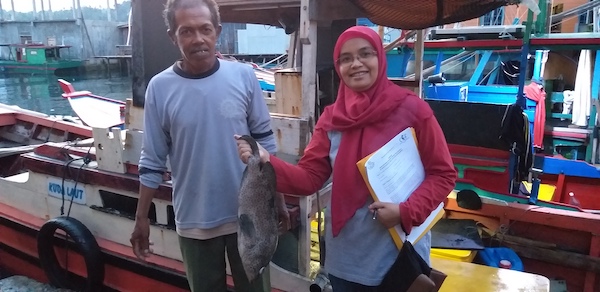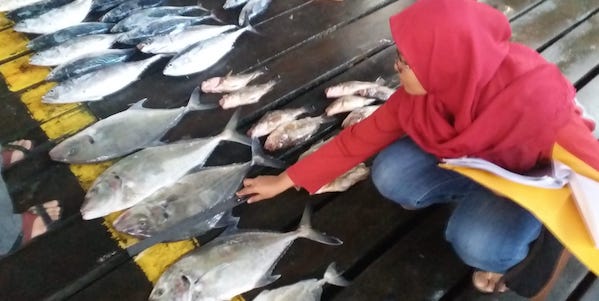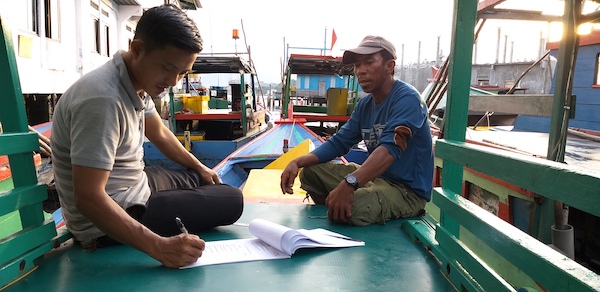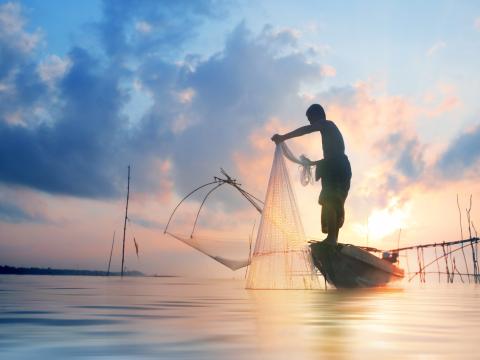Fisheries Management Area Research: The Benefits of Coral Fisheries in the Anambas Islands Conservation Area
Leny Dwihastuty is studying the benefits of Ministry Regulation Kepmen KP No 47 Tahun 2016 on the Red Snapper (Lutjanus bitaeniatus), Marbled Grouper (Epinephelus fuscoguttatus), Crimson Jobfish (Pristipomoides Filamentosus), and Bigeye Trevally (Caranx sexfasciatus) fisheries in the Anambas Islands Regency. The Anambas Islands, located on the western edge of the Coral Triangle, are a strategic part of the National Waters Conservation Area or Kawasan Konservasi Perairan Nasional (KKPN) and also located within Fisheries Management Area (FMA) 711. The Kepmen KP No 47 Tahun 2016 estimated the potential capacity of all the fisheries in Indonesia’s FMAs, set a Total Allowable Catch (TAC) limit for each, and restricted catch to 50% TAC in an effort to sustainably manage these resources. Leny’s research, “The Benefits of Coral Fisheries in the Anambas Islands Conservation Area,” uses data from four fisheries to understand how restrictions on the catch can create spillover effects benefitting both the marine ecosystem and local fishers.

Leny focused on these four coral fish species because of their dual role as indicators of coral reef health and the main source of income for local fishers. She used Maximum Sustainable Yield (MSY) - the maximum level at which natural resources can be routinely exploited without long-term depletion - as an indicator of the biological benefits, and Maximum Economic Yield (MEY) - the level of effort that maximizes sustainable net returns from fishing - as an indicator of economic benefits, and the number of fishers as an indicator of the social benefits. Her findings were as follows:
Biological: The Red Snapper and Bigeye Trevally fisheries are still underexploited or below the MSY level and the catch was below the 50% TAC limit imposed by the regulation. The Marbled Grouper fishery is also underexploited (below MSY), however, this fishery exceeded its limit of 50% TAC. The Crimson Jobfish fishery is already overexploited (above MSY) and the catch was way beyond the regulation limit.

Economic: These four fisheries have a combined economic value of roughly 300 billion rupiah (22 million USD) per year. However, the total profits from these fisheries still fall slightly under their economic value, with total profits per year around 296 billion rupiah (21 million USD).
Social: The number of fishers exploiting these four fisheries is 3,646, which exceeds the number regulated by the Kepmen KP No 47 Tahun 2016, which was 1,019 people. In order to comply with the regulation, the number of fishers within the area must decrease significantly, which will help the fisheries to reach MEY, and ensure the sustainability of the ecosystem, but may put many fishers out of work.

In general, Leny’s research has shown that the Kepmen KP No. 47 Tahun 2016 regulation is an important tool for supporting sustainability in the Anambas Islands, but issues with overfishing, the value-profit gap, and overexploitation still need to be addressed.
Last month, Leny presented her research to Indonesia's Ministry of Marine Affairs and Fisheries (MMAF) Directorate of Conservation and Marine Biodiversity. Her findings are relevant to the government’s ongoing efforts to evaluate their own regulations, especially in the Marine Spatial fields. Roughly twenty people from MMAF participated in the day of the dissemination and were eager to discuss how finding such as these could be used to formulate regulations to ensure both economic and ecological health in the FMAs. We hope that this research will contribute to the Sustainable Development Goals of Indonesia’s FMAs.
Our FMA researchers will disseminate their work throughout 2020, and CSF-Indonesia will continue this collaborative research program into 2021 with additional FMAs. This work is made possible by the generous support of Margaret A. Cargill Philanthropies.
- Log in to post comments

